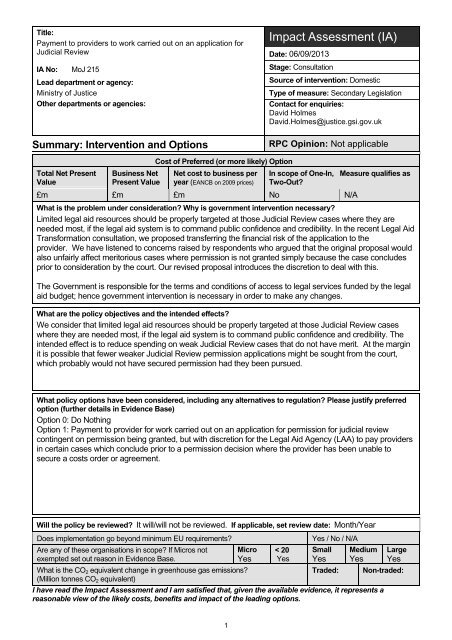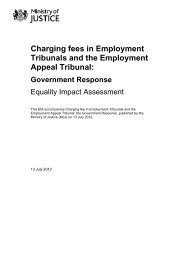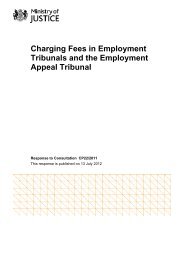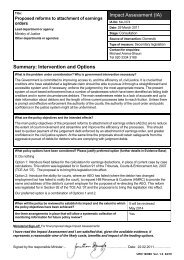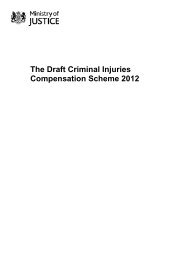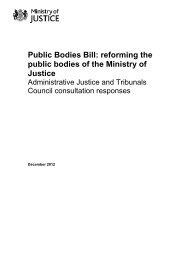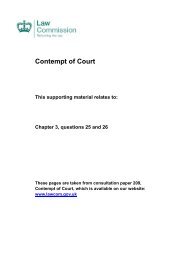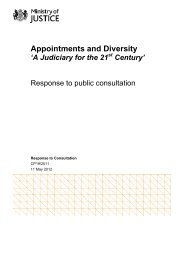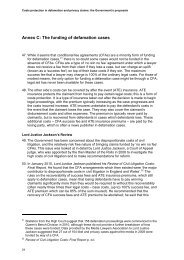Payment to providers to work carried out on an ... - Ministry of Justice
Payment to providers to work carried out on an ... - Ministry of Justice
Payment to providers to work carried out on an ... - Ministry of Justice
Create successful ePaper yourself
Turn your PDF publications into a flip-book with our unique Google optimized e-Paper software.
Title:<str<strong>on</strong>g>Payment</str<strong>on</strong>g> <str<strong>on</strong>g>to</str<strong>on</strong>g> <str<strong>on</strong>g>providers</str<strong>on</strong>g> <str<strong>on</strong>g>to</str<strong>on</strong>g> <str<strong>on</strong>g>work</str<strong>on</strong>g> <str<strong>on</strong>g>carried</str<strong>on</strong>g> <str<strong>on</strong>g>out</str<strong>on</strong>g> <strong>on</strong> <strong>an</strong> applicati<strong>on</strong> forJudicial ReviewIA No: MoJ 215Lead department or agency:<strong>Ministry</strong> <strong>of</strong> <strong>Justice</strong>Other departments or agencies:Summary: Interventi<strong>on</strong> <strong>an</strong>d Opti<strong>on</strong>sImpact Assessment (IA)Date: 06/09/2013Stage: C<strong>on</strong>sultati<strong>on</strong>Source <strong>of</strong> interventi<strong>on</strong>: DomesticType <strong>of</strong> measure: Sec<strong>on</strong>dary Legislati<strong>on</strong>C<strong>on</strong>tact for enquiries:David HolmesDavid.Holmes@justice.gsi.gov.ukRPC Opini<strong>on</strong>: Not applicableTotal Net PresentValueBusiness NetPresent ValueCost <strong>of</strong> Preferred (or more likely) Opti<strong>on</strong>Net cost <str<strong>on</strong>g>to</str<strong>on</strong>g> business peryear (EANCB <strong>on</strong> 2009 prices)In scope <strong>of</strong> One-In,Two-Out?Measure qualifies as£m £m £m No N/AWhat is the problem under c<strong>on</strong>siderati<strong>on</strong>? Why is government interventi<strong>on</strong> necessary?Limited legal aid resources should be properly targeted at those Judicial Review cases where they areneeded most, if the legal aid system is <str<strong>on</strong>g>to</str<strong>on</strong>g> comm<strong>an</strong>d public c<strong>on</strong>fidence <strong>an</strong>d credibility. In the recent Legal AidTr<strong>an</strong>sformati<strong>on</strong> c<strong>on</strong>sultati<strong>on</strong>, we proposed tr<strong>an</strong>sferring the fin<strong>an</strong>cial risk <strong>of</strong> the applicati<strong>on</strong> <str<strong>on</strong>g>to</str<strong>on</strong>g> theprovider. We have listened <str<strong>on</strong>g>to</str<strong>on</strong>g> c<strong>on</strong>cerns raised by resp<strong>on</strong>dents who argued that the original proposal wouldalso unfairly affect meri<str<strong>on</strong>g>to</str<strong>on</strong>g>rious cases where permissi<strong>on</strong> is not gr<strong>an</strong>ted simply because the case c<strong>on</strong>cludesprior <str<strong>on</strong>g>to</str<strong>on</strong>g> c<strong>on</strong>siderati<strong>on</strong> by the court. Our revised proposal introduces the discreti<strong>on</strong> <str<strong>on</strong>g>to</str<strong>on</strong>g> deal with this.The Government is resp<strong>on</strong>sible for the terms <strong>an</strong>d c<strong>on</strong>diti<strong>on</strong>s <strong>of</strong> access <str<strong>on</strong>g>to</str<strong>on</strong>g> legal services funded by the legalaid budget; hence government interventi<strong>on</strong> is necessary in order <str<strong>on</strong>g>to</str<strong>on</strong>g> make <strong>an</strong>y ch<strong>an</strong>ges.What are the policy objectives <strong>an</strong>d the intended effects?We c<strong>on</strong>sider that limited legal aid resources should be properly targeted at those Judicial Review caseswhere they are needed most, if the legal aid system is <str<strong>on</strong>g>to</str<strong>on</strong>g> comm<strong>an</strong>d public c<strong>on</strong>fidence <strong>an</strong>d credibility. Theintended effect is <str<strong>on</strong>g>to</str<strong>on</strong>g> reduce spending <strong>on</strong> weak Judicial Review cases that do not have merit. At the marginit is possible that fewer weaker Judicial Review permissi<strong>on</strong> applicati<strong>on</strong>s might be sought from the court,which probably would not have secured permissi<strong>on</strong> had they been pursued.What policy opti<strong>on</strong>s have been c<strong>on</strong>sidered, including <strong>an</strong>y alternatives <str<strong>on</strong>g>to</str<strong>on</strong>g> regulati<strong>on</strong>? Please justify preferredopti<strong>on</strong> (further details in Evidence Base)Opti<strong>on</strong> 0: Do NothingOpti<strong>on</strong> 1: <str<strong>on</strong>g>Payment</str<strong>on</strong>g> <str<strong>on</strong>g>to</str<strong>on</strong>g> provider for <str<strong>on</strong>g>work</str<strong>on</strong>g> <str<strong>on</strong>g>carried</str<strong>on</strong>g> <str<strong>on</strong>g>out</str<strong>on</strong>g> <strong>on</strong> <strong>an</strong> applicati<strong>on</strong> for permissi<strong>on</strong> for judicial reviewc<strong>on</strong>tingent <strong>on</strong> permissi<strong>on</strong> being gr<strong>an</strong>ted, but with discreti<strong>on</strong> for the Legal Aid Agency (LAA) <str<strong>on</strong>g>to</str<strong>on</strong>g> pay <str<strong>on</strong>g>providers</str<strong>on</strong>g>in certain cases which c<strong>on</strong>clude prior <str<strong>on</strong>g>to</str<strong>on</strong>g> a permissi<strong>on</strong> decisi<strong>on</strong> where the provider has been unable <str<strong>on</strong>g>to</str<strong>on</strong>g>secure a costs order or agreement.Will the policy be reviewed? It will/will not be reviewed. If applicable, set review date: M<strong>on</strong>th/YearDoes implementati<strong>on</strong> go bey<strong>on</strong>d minimum EU requirements?Are <strong>an</strong>y <strong>of</strong> these org<strong>an</strong>isati<strong>on</strong>s in scope? If Micros notexempted set <str<strong>on</strong>g>out</str<strong>on</strong>g> reas<strong>on</strong> in Evidence Base.MicroYes< 20YesYes / No / N/ASmallYesMediumYesLargeYesWhat is the CO 2 equivalent ch<strong>an</strong>ge in greenhouse gas emissi<strong>on</strong>s?Traded: N<strong>on</strong>-traded:(Milli<strong>on</strong> <str<strong>on</strong>g>to</str<strong>on</strong>g>nnes CO 2 equivalent)I have read the Impact Assessment <strong>an</strong>d I am satisfied that, given the available evidence, it represents areas<strong>on</strong>able view <strong>of</strong> the likely costs, benefits <strong>an</strong>d impact <strong>of</strong> the leading opti<strong>on</strong>s.1
Signed by the resp<strong>on</strong>sible SELECT SIGNATORY: Date: 06/09/20132
Summary: Analysis & Evidence Policy Opti<strong>on</strong> 1Descripti<strong>on</strong>: <str<strong>on</strong>g>Payment</str<strong>on</strong>g> <str<strong>on</strong>g>to</str<strong>on</strong>g> provider c<strong>on</strong>tingent <strong>on</strong> permissi<strong>on</strong> being gr<strong>an</strong>ted, but with discreti<strong>on</strong> for the LAA <str<strong>on</strong>g>to</str<strong>on</strong>g> pay<str<strong>on</strong>g>providers</str<strong>on</strong>g> in certain cases which c<strong>on</strong>clude prior <str<strong>on</strong>g>to</str<strong>on</strong>g> a permissi<strong>on</strong> decisi<strong>on</strong> where the provider has been unable <str<strong>on</strong>g>to</str<strong>on</strong>g> secure acost order or agreement as part <strong>of</strong> a settlement.FULL ECONOMIC ASSESSMENTPrice BaseYear12/13COSTS (£m)PV BaseYearTime PeriodYearsTotal Tr<strong>an</strong>siti<strong>on</strong>(C<strong>on</strong>st<strong>an</strong>t Price) YearsNet Benefit (Present Value (PV)) (£m)Low: Opti<strong>on</strong>al High: Opti<strong>on</strong>al Best Estimate:Average Annual(excl. Tr<strong>an</strong>siti<strong>on</strong>) (C<strong>on</strong>st<strong>an</strong>t Price)Low Opti<strong>on</strong>al £1mHigh Opti<strong>on</strong>al £3mBest EstimateNegligibleTotal Cost(Present Value)Descripti<strong>on</strong> <strong>an</strong>d scale <strong>of</strong> key m<strong>on</strong>etised costs by ‘main affected groupsLegal aid <str<strong>on</strong>g>providers</str<strong>on</strong>g>: Will experience a fall in income from legal aid provisi<strong>on</strong> for Judicial Review cases wherepermissi<strong>on</strong> is not gr<strong>an</strong>ted. This is expected <str<strong>on</strong>g>to</str<strong>on</strong>g> be in the r<strong>an</strong>ge <strong>of</strong> £1milli<strong>on</strong>-£3milli<strong>on</strong> per <strong>an</strong>num. It ispossible in some cases that the same amount <strong>of</strong> <str<strong>on</strong>g>work</str<strong>on</strong>g> as now will be undertaken, but will not be funded bythe legal aid budget. In other cases less <str<strong>on</strong>g>work</str<strong>on</strong>g> may be undertaken, for example if fewer applicati<strong>on</strong>s forpermissi<strong>on</strong> in Judicial Review cases are sought in future.Other key n<strong>on</strong>-m<strong>on</strong>etised costs by ‘main affected groups’Legal Aid Agency (LAA): There will be small <strong>on</strong>going costs as a result <strong>of</strong> having <str<strong>on</strong>g>to</str<strong>on</strong>g> c<strong>on</strong>sider whether <str<strong>on</strong>g>to</str<strong>on</strong>g>award payment in cases that c<strong>on</strong>clude before a permissi<strong>on</strong> decisi<strong>on</strong>.HM Courts <strong>an</strong>d Tribunals Service (HMCTS): May experience reduced court fee income if fewerapplicati<strong>on</strong>s for permissi<strong>on</strong> in Judicial Review cases are sought in future.BENEFITS (£m)Total Tr<strong>an</strong>siti<strong>on</strong>(C<strong>on</strong>st<strong>an</strong>t Price) YearsAverage Annual(excl. Tr<strong>an</strong>siti<strong>on</strong>) (C<strong>on</strong>st<strong>an</strong>t Price)Total Benefit(Present Value)Low Opti<strong>on</strong>al £1m £1mHigh Opti<strong>on</strong>al £3m £3mBest EstimateDescripti<strong>on</strong> <strong>an</strong>d scale <strong>of</strong> key m<strong>on</strong>etised benefits by ‘main affected groups’LAA: There will be savings in the r<strong>an</strong>ge <strong>of</strong> £1milli<strong>on</strong>-£3milli<strong>on</strong> from no l<strong>on</strong>ger paying legal aid <str<strong>on</strong>g>providers</str<strong>on</strong>g> incases where permissi<strong>on</strong> is not gr<strong>an</strong>ted. In additi<strong>on</strong> there may be savings from reduced court feeexpenditure if fewer legally aided Judicial Review permissi<strong>on</strong> applicati<strong>on</strong>s are made in future.Other key n<strong>on</strong>-m<strong>on</strong>etised benefits by ‘main affected groups’HMCTS: May experience reduced court costs if fewer Judicial Review permissi<strong>on</strong> applicati<strong>on</strong>s are made infuture.Legal aid <str<strong>on</strong>g>providers</str<strong>on</strong>g>: In cases where less <str<strong>on</strong>g>work</str<strong>on</strong>g> is undertaken resources would be freed for other pr<strong>of</strong>itableacti itiesKey assumpti<strong>on</strong>s/sensitivities/risks Discount rate (%) LAA end-point codes have been used <str<strong>on</strong>g>to</str<strong>on</strong>g> assess the costs <strong>an</strong>d benefits <strong>of</strong> the proposals. Thedescripti<strong>on</strong> <strong>of</strong> the end-point codes me<strong>an</strong>s there is some uncertainty as <str<strong>on</strong>g>to</str<strong>on</strong>g> how m<strong>an</strong>y cases would beaffected by the proposal which is why the costs <strong>an</strong>d benefits are presented as a r<strong>an</strong>ge. Savings are also subject <str<strong>on</strong>g>to</str<strong>on</strong>g> the number <strong>of</strong> cases in which the LAA’s discreti<strong>on</strong> <str<strong>on</strong>g>to</str<strong>on</strong>g> pay the provider (incases which c<strong>on</strong>clude before permissi<strong>on</strong> is c<strong>on</strong>sidered by the court) is exercised in the provider’sfavour, <strong>an</strong>d in which a provider obtains costs from the opp<strong>on</strong>ent. Possible costs <str<strong>on</strong>g>to</str<strong>on</strong>g> HMCTS from reduced <str<strong>on</strong>g>to</str<strong>on</strong>g>tal court fee income are assumed <str<strong>on</strong>g>to</str<strong>on</strong>g> be comparable <str<strong>on</strong>g>to</str<strong>on</strong>g>possible benefits <str<strong>on</strong>g>to</str<strong>on</strong>g> HMCTS from reduced overall costs.BUSINESS ASSESSMENT (Opti<strong>on</strong> 1)Direct impact <strong>on</strong> business (Equivalent Annual) £m: In scope <strong>of</strong> OITO? Measure qualifies asCosts: n/a Benefits: n/a Net: n/a No N/A3
Evidence Base (for summary sheets)Introducti<strong>on</strong>Background1. This Impact Assessment (IA) accomp<strong>an</strong>ies the <strong>Ministry</strong> <strong>of</strong> <strong>Justice</strong>’s (MoJ’s) c<strong>on</strong>sultati<strong>on</strong> <strong>on</strong> JudicialReview: Proposals for further reform. This is a further proposal <str<strong>on</strong>g>to</str<strong>on</strong>g> that set <str<strong>on</strong>g>out</str<strong>on</strong>g> in the Legal AidTr<strong>an</strong>sformati<strong>on</strong> document Tr<strong>an</strong>sforming Legal Aid: Delivering a More Credible <strong>an</strong>d Efficient System”.(pages 30-33) That c<strong>on</strong>sultati<strong>on</strong> document was published <strong>on</strong> 9 April 2013 <strong>an</strong>d c<strong>an</strong> be found at:www.justice.gov.uk.2. The legal aid scheme involves the public procurement <strong>of</strong> legal services <strong>an</strong>d determines the terms<strong>an</strong>d c<strong>on</strong>diti<strong>on</strong>s <strong>of</strong> access <str<strong>on</strong>g>to</str<strong>on</strong>g> these services. Legal aid fund expenditure was almost £2bn in 2012/13,with around £975m spent <strong>on</strong> criminal legal aid <strong>an</strong>d £940m spent <strong>on</strong> civil legal aid 1 . The Legal AidAgency (LAA) is resp<strong>on</strong>sible for administering the legal aid scheme in Engl<strong>an</strong>d <strong>an</strong>d Wales.Policy Objectives3. The main policy objective <strong>an</strong>d intended effect is <str<strong>on</strong>g>to</str<strong>on</strong>g> ensure public c<strong>on</strong>fidence in the civil legal aidsystem. In reviewing every area <strong>of</strong> expenditure <str<strong>on</strong>g>to</str<strong>on</strong>g> achieve savings <str<strong>on</strong>g>to</str<strong>on</strong>g> reduce the fiscal deficit, theGovernment is c<strong>on</strong>cerned <str<strong>on</strong>g>to</str<strong>on</strong>g> ensure that limited public resources are targeted at those cases whichjustify it <strong>an</strong>d those people who need it.4. Limited legal aid resources should be properly targeted at those Judicial Review cases where theyare needed most, if the legal aid system is <str<strong>on</strong>g>to</str<strong>on</strong>g> comm<strong>an</strong>d public c<strong>on</strong>fidence <strong>an</strong>d credibility. In theTr<strong>an</strong>sforming Legal Aid C<strong>on</strong>sultati<strong>on</strong>, published in April this year, we proposed tr<strong>an</strong>sferring thefin<strong>an</strong>cial risk <strong>of</strong> the applicati<strong>on</strong> <str<strong>on</strong>g>to</str<strong>on</strong>g> the provider in order <str<strong>on</strong>g>to</str<strong>on</strong>g> provide a greater incentive <str<strong>on</strong>g>to</str<strong>on</strong>g> give carefulc<strong>on</strong>siderati<strong>on</strong> <str<strong>on</strong>g>to</str<strong>on</strong>g> the strength <strong>of</strong> the case before applying for permissi<strong>on</strong> for Judicial Review.5. We have listened <str<strong>on</strong>g>to</str<strong>on</strong>g> c<strong>on</strong>cerns raised by a number <strong>of</strong> resp<strong>on</strong>dents who argued that the originalproposal would also unfairly affect meri<str<strong>on</strong>g>to</str<strong>on</strong>g>rious cases where permissi<strong>on</strong> is not gr<strong>an</strong>ted simplybecause the case c<strong>on</strong>cludes in the claim<strong>an</strong>t’s favour prior <str<strong>on</strong>g>to</str<strong>on</strong>g> c<strong>on</strong>siderati<strong>on</strong> by the court. As a result,the revised policy <strong>on</strong> which we are now c<strong>on</strong>sulting introduces a discreti<strong>on</strong> <str<strong>on</strong>g>to</str<strong>on</strong>g> permit the LAA <str<strong>on</strong>g>to</str<strong>on</strong>g> paythe provider in certain cases which c<strong>on</strong>clude prior <str<strong>on</strong>g>to</str<strong>on</strong>g> a permissi<strong>on</strong> decisi<strong>on</strong> with<str<strong>on</strong>g>out</str<strong>on</strong>g> a costs order oragreement. We have proposed a set <strong>of</strong> criteria for the LAA <str<strong>on</strong>g>to</str<strong>on</strong>g> apply when c<strong>on</strong>sidering whether or not<str<strong>on</strong>g>to</str<strong>on</strong>g> exercise this discreti<strong>on</strong> in individual cases.Policy6. The policy opti<strong>on</strong> c<strong>on</strong>sidered in this Impact Assessment is as follows:Restricti<strong>on</strong> <strong>of</strong> legal aid payments so that <str<strong>on</strong>g>providers</str<strong>on</strong>g> are <strong>on</strong>ly paid for <str<strong>on</strong>g>work</str<strong>on</strong>g> <strong>on</strong> a Judicial Reviewpermissi<strong>on</strong> applicati<strong>on</strong> (including a request for rec<strong>on</strong>siderati<strong>on</strong> <strong>of</strong> the applicati<strong>on</strong> at a hearing, therenewal hearing or <strong>an</strong> <strong>on</strong>ward appeal <str<strong>on</strong>g>to</str<strong>on</strong>g> the Court <strong>of</strong> Appeal) if permissi<strong>on</strong> is gr<strong>an</strong>ted or if theLAA chooses <str<strong>on</strong>g>to</str<strong>on</strong>g> exercise discreti<strong>on</strong> <str<strong>on</strong>g>to</str<strong>on</strong>g> pay <str<strong>on</strong>g>providers</str<strong>on</strong>g> in certain cases which c<strong>on</strong>clude prior <str<strong>on</strong>g>to</str<strong>on</strong>g> apermissi<strong>on</strong> decisi<strong>on</strong> with<str<strong>on</strong>g>out</str<strong>on</strong>g> a costs order or agreement.Main Affected Groups7. The following key groups are likely <str<strong>on</strong>g>to</str<strong>on</strong>g> be affected by the proposals:Civil legal aid claim<strong>an</strong>ts1 Rounded <str<strong>on</strong>g>to</str<strong>on</strong>g> the nearest £5m. Source: http://www.justice.gov.uk/downloads/publicati<strong>on</strong>s/corporate-reports/lsc/legal-aidstats-12-13.pdf4
Civil legal aid <str<strong>on</strong>g>providers</str<strong>on</strong>g>Defend<strong>an</strong>tsThe LAA, which is resp<strong>on</strong>sible for administering legal aid.Her Majesty’s Courts <strong>an</strong>d Tribunals Service (HMCTS)Costs & Benefits8. This IA identifies both m<strong>on</strong>etised <strong>an</strong>d n<strong>on</strong>-m<strong>on</strong>etised impacts <strong>on</strong> individuals, groups <strong>an</strong>d businessesin the UK, with the aim <strong>of</strong> underst<strong>an</strong>ding what the overall impact <strong>on</strong> society might be fromimplementing these proposals. The costs <strong>an</strong>d benefits <strong>of</strong> each proposal are compared <str<strong>on</strong>g>to</str<strong>on</strong>g> the d<strong>on</strong>othing opti<strong>on</strong>. Impact Assessments place a str<strong>on</strong>g emphasis <strong>on</strong> valuing the costs <strong>an</strong>d benefits inm<strong>on</strong>etary terms (including estimating the value <strong>of</strong> goods <strong>an</strong>d services that are not traded). Howeverthere are some import<strong>an</strong>t aspects that c<strong>an</strong>not always sensibly be m<strong>on</strong>etised.9. All savings figures have been rounded <str<strong>on</strong>g>to</str<strong>on</strong>g> the nearest £1milli<strong>on</strong>.Assumpti<strong>on</strong>s10. The following assumpti<strong>on</strong>s have been made in the estimati<strong>on</strong> <strong>of</strong> the costs <strong>an</strong>d benefits.(i) The provider resp<strong>on</strong>se <str<strong>on</strong>g>to</str<strong>on</strong>g> the proposal is uncertain. Existing me<strong>an</strong>s <strong>an</strong>d merits tests arenot being ch<strong>an</strong>ged as part <strong>of</strong> this proposal. Providers should be incentivised <str<strong>on</strong>g>to</str<strong>on</strong>g> c<strong>on</strong>sidercases more carefully before issuing Judicial Review proceedings. We have assumed thatat the margin there may be a reducti<strong>on</strong> in the number <strong>of</strong> weaker Judicial Reviewpermissi<strong>on</strong>s applicati<strong>on</strong>s, <strong>an</strong>d that these probably would not have secured permissi<strong>on</strong> hadthey been pursued.(ii)(iii)The proposed discreti<strong>on</strong> <strong>of</strong> the LAA <str<strong>on</strong>g>to</str<strong>on</strong>g> award payment in cases that c<strong>on</strong>clude before apermissi<strong>on</strong> decisi<strong>on</strong> is made by the court is designed <str<strong>on</strong>g>to</str<strong>on</strong>g> ensure that legal aid <str<strong>on</strong>g>providers</str<strong>on</strong>g> d<strong>on</strong>ot refuse <str<strong>on</strong>g>to</str<strong>on</strong>g> take <strong>on</strong> genuinely meri<str<strong>on</strong>g>to</str<strong>on</strong>g>rious Judicial Review cases more generally, giventhe risk <strong>of</strong> n<strong>on</strong> payment.The civil legal aid remunerati<strong>on</strong> reforms have been modelled against a flat baseline <strong>of</strong>2012/13 closed cases.11. The data used in this Impact Assessment is drawn from the LAA <strong>an</strong>d includes Judicial Review <str<strong>on</strong>g>work</str<strong>on</strong>g>undertaken at the pre-acti<strong>on</strong> stage before court proceedings have been issued. The accuracy <strong>of</strong> thisdata is dependent up<strong>on</strong> how case <str<strong>on</strong>g>out</str<strong>on</strong>g>comes have been recorded by legal aid <str<strong>on</strong>g>providers</str<strong>on</strong>g>. Thesevolumes are not directly comparable <str<strong>on</strong>g>to</str<strong>on</strong>g> the Administrative Court data <strong>on</strong> the overall volumes <strong>of</strong>Judicial Review cases where court proceedings have been issued (i.e. cases that are formally lodgedat the Administrative Court) <strong>an</strong>d which are included in the other Impact Assessments <strong>an</strong>dc<strong>on</strong>sultati<strong>on</strong> document.Opti<strong>on</strong> 0: Do Nothing12. At present all Judicial Review cases funded by legal aid receive payment for the permissi<strong>on</strong>applicati<strong>on</strong> stage <strong>of</strong> their case. In the do nothing opti<strong>on</strong> this would c<strong>on</strong>tinue <strong>an</strong>d <str<strong>on</strong>g>providers</str<strong>on</strong>g> would bepaid for the <str<strong>on</strong>g>work</str<strong>on</strong>g> <strong>on</strong> all permissi<strong>on</strong> applicati<strong>on</strong>s regardless <strong>of</strong> the <str<strong>on</strong>g>out</str<strong>on</strong>g>come.13. As this opti<strong>on</strong> is compared against itself, its costs <strong>an</strong>d benefits are necessarily zero, as is its NetPresent Value (NPV).Opti<strong>on</strong> 1 – <str<strong>on</strong>g>Payment</str<strong>on</strong>g> <str<strong>on</strong>g>to</str<strong>on</strong>g> provider for <str<strong>on</strong>g>work</str<strong>on</strong>g> <str<strong>on</strong>g>carried</str<strong>on</strong>g> <str<strong>on</strong>g>out</str<strong>on</strong>g> <strong>on</strong> <strong>an</strong> applicati<strong>on</strong> for permissi<strong>on</strong> for JudicialReview c<strong>on</strong>tingent <strong>on</strong> permissi<strong>on</strong> being gr<strong>an</strong>ted; with a discreti<strong>on</strong> <str<strong>on</strong>g>to</str<strong>on</strong>g> permit the LAA <str<strong>on</strong>g>to</str<strong>on</strong>g> pay<str<strong>on</strong>g>providers</str<strong>on</strong>g> in certain cases which c<strong>on</strong>clude before a permissi<strong>on</strong> decisi<strong>on</strong>5
Descripti<strong>on</strong>14. This opti<strong>on</strong> proposes that <str<strong>on</strong>g>providers</str<strong>on</strong>g> should <strong>on</strong>ly be paid for <str<strong>on</strong>g>work</str<strong>on</strong>g> <str<strong>on</strong>g>carried</str<strong>on</strong>g> <str<strong>on</strong>g>out</str<strong>on</strong>g> <strong>on</strong> <strong>an</strong> applicati<strong>on</strong> forpermissi<strong>on</strong> (including a request for rec<strong>on</strong>siderati<strong>on</strong> <strong>of</strong> the applicati<strong>on</strong> at a hearing, the renewalhearing or <strong>an</strong> <strong>on</strong>ward permissi<strong>on</strong> appeal <str<strong>on</strong>g>to</str<strong>on</strong>g> the Court <strong>of</strong> Appeal), if permissi<strong>on</strong> is gr<strong>an</strong>ted by theCourt. Legal aid would still be available for pre-proceedings <str<strong>on</strong>g>work</str<strong>on</strong>g>, <strong>an</strong>d reas<strong>on</strong>able disbursementssuch as expert fees <strong>an</strong>d court fees (but not Counsel’s fees) which arise in preparing the permissi<strong>on</strong>applicati<strong>on</strong> will be paid. This opti<strong>on</strong> also includes the introducti<strong>on</strong> <strong>of</strong> a discreti<strong>on</strong> <str<strong>on</strong>g>to</str<strong>on</strong>g> permit the LAA <str<strong>on</strong>g>to</str<strong>on</strong>g>pay <str<strong>on</strong>g>providers</str<strong>on</strong>g> in certain cases which c<strong>on</strong>clude prior <str<strong>on</strong>g>to</str<strong>on</strong>g> a permissi<strong>on</strong> decisi<strong>on</strong>. In additi<strong>on</strong> if <strong>an</strong> initialpermissi<strong>on</strong> applicati<strong>on</strong> is not successful but permissi<strong>on</strong> is subsequently secured, e.g. at <strong>an</strong> oralrenewal, then the legal aid provider would be paid for all <str<strong>on</strong>g>work</str<strong>on</strong>g> including that relating <str<strong>on</strong>g>to</str<strong>on</strong>g> the initialpermissi<strong>on</strong> applicati<strong>on</strong>.CostsLegal aid <str<strong>on</strong>g>providers</str<strong>on</strong>g>15. Legal aid <str<strong>on</strong>g>providers</str<strong>on</strong>g> would experience a reducti<strong>on</strong> in income from the legal aid fund in relati<strong>on</strong> <str<strong>on</strong>g>to</str<strong>on</strong>g>cases which do not secure permissi<strong>on</strong> in future <strong>an</strong>d which are no l<strong>on</strong>ger funded by the LAA. The<strong>an</strong>alysis below estimates the possible aggregate size <strong>of</strong> this reducti<strong>on</strong> in income.16. In some cases the legal aid provider might undertake the same amount <strong>of</strong> <str<strong>on</strong>g>work</str<strong>on</strong>g> as now but receiveless income from the LAA. In other cases the legal aid provider might undertake less <str<strong>on</strong>g>work</str<strong>on</strong>g>, forexample if permissi<strong>on</strong> is not sought in future.17. Where permissi<strong>on</strong> is not sought in future this is assumed <str<strong>on</strong>g>to</str<strong>on</strong>g> apply <strong>on</strong>ly <str<strong>on</strong>g>to</str<strong>on</strong>g> weaker applicati<strong>on</strong>s whichprobably would not have secured permissi<strong>on</strong> had they been pursued.18. Table 1 presents data drawn from the LAA 2 showing the number <strong>of</strong> Judicial Review cases thatreceived legal aid funding in 2011/12 <strong>an</strong>d 2012/13. The data is split by LAA end-point codes 3 . Legalaid <str<strong>on</strong>g>providers</str<strong>on</strong>g> are asked <str<strong>on</strong>g>to</str<strong>on</strong>g> select <strong>on</strong>e <strong>of</strong> codes E-J when recording the <str<strong>on</strong>g>out</str<strong>on</strong>g>come <strong>of</strong> a Judicial Reviewcertificate but LAA records show that <str<strong>on</strong>g>providers</str<strong>on</strong>g> have also been selecting A-D in judicial review cases(those codes are normally <strong>on</strong>ly for n<strong>on</strong> Judicial Review cases). For this reas<strong>on</strong> all Judicial Reviewcertificates recorded against end-point codes A-J have been c<strong>on</strong>sidered in this Impact Assessment.19. Table 1 gives the best available data <strong>on</strong> the number <strong>of</strong> Judicial Review cases that received legal aidfunding for legal representati<strong>on</strong>. The costs <strong>an</strong>d benefits have been calculated using the latest data,2012/13 end-point codes, but both 2011/12 <strong>an</strong>d 2012/13 are shown below for completeness.Table 1: LAA Judicial Review end-point code dataEnd-point2011/12 2012/13Descripti<strong>on</strong>CodeCases CasesA No proceedings issued 618 597B Proceedings issued, no final hearing 291 315C Determined at final hearing 181 148D Determined <strong>on</strong> appeal 9 8E No proceedings have been issued or where a caseis withdrawn or settled before the court makes <strong>an</strong> 1657 1424initial decisi<strong>on</strong> whether or not <str<strong>on</strong>g>to</str<strong>on</strong>g> gr<strong>an</strong>t permissi<strong>on</strong>F Permissi<strong>on</strong> not gr<strong>an</strong>ted, c<strong>on</strong>cluded at firstapplicati<strong>on</strong> stage (usually papers)652 538G Permissi<strong>on</strong> not gr<strong>an</strong>ted, c<strong>on</strong>cluded after renewedapplicati<strong>on</strong>193 2162The data <strong>on</strong> the number <strong>of</strong> legally aided JR cases in this Impact Assessment are drawn from the Legal Aid Agency <strong>an</strong>d includes JR <str<strong>on</strong>g>work</str<strong>on</strong>g>undertaken at the pre-acti<strong>on</strong> stage. As such, these volumes are not directly comparable <str<strong>on</strong>g>to</str<strong>on</strong>g> the data <strong>on</strong> the overall volumes <strong>of</strong> JR applicati<strong>on</strong>s(i.e. cases that are formally lodged at the Administrative Court) which are included in the other Impact Assessments <strong>an</strong>d c<strong>on</strong>sultati<strong>on</strong> document3 www.justice.gov.uk/downloads/forms/legal-aid/civil-forms/certificate-<str<strong>on</strong>g>out</str<strong>on</strong>g>comes-checklist-versi<strong>on</strong>-2.pdf6
Heard <strong>an</strong>d permissi<strong>on</strong> refused(endpoints F&G) 754 1.0 1.0Proceedings issued, no final hearing(endpoint B) 315 0.0 0.4C<strong>on</strong>cluded before a permissi<strong>on</strong> decisi<strong>on</strong>,but uncertain if issued (endpoint E) 1,424 0.0 1.9Total 2,493 1 3Note: costs have been rounded <str<strong>on</strong>g>to</str<strong>on</strong>g> the nearest £1m.24. There may also be additi<strong>on</strong>al costs <str<strong>on</strong>g>to</str<strong>on</strong>g> <str<strong>on</strong>g>providers</str<strong>on</strong>g> who settle before a permissi<strong>on</strong> decisi<strong>on</strong> if they have<str<strong>on</strong>g>to</str<strong>on</strong>g> pay legal costs that were previously paid by the LAA.Claim<strong>an</strong>ts25. It is likely that fewer weaker Judicial Review permissi<strong>on</strong> applicati<strong>on</strong>s will be made. It is unclearwhether this would generate a cost <str<strong>on</strong>g>to</str<strong>on</strong>g> claim<strong>an</strong>ts, as these cases probably would not have securedpermissi<strong>on</strong> had they been pursued. There may be a cost <str<strong>on</strong>g>to</str<strong>on</strong>g> such claim<strong>an</strong>ts from a reduced delay inresolving their Judicial Review, if they value reducti<strong>on</strong> in delay positively.HMCTS26. If fewer permissi<strong>on</strong> applicati<strong>on</strong>s are made there might be a reducti<strong>on</strong> in <str<strong>on</strong>g>to</str<strong>on</strong>g>tal court fee income. Thisis assumed <str<strong>on</strong>g>to</str<strong>on</strong>g> be comparable <str<strong>on</strong>g>to</str<strong>on</strong>g> the c<strong>on</strong>sequent reducti<strong>on</strong> in overall court costs. HMCTS operates<strong>on</strong> a cost recovery basis in the l<strong>on</strong>ger term.LAA27. Removing payments for permissi<strong>on</strong> applicati<strong>on</strong> in JR will lead <str<strong>on</strong>g>to</str<strong>on</strong>g> a small <strong>on</strong>e-<strong>of</strong>f increase in LAAadministrati<strong>on</strong> costs. The LAA may need <str<strong>on</strong>g>to</str<strong>on</strong>g> amend its IT systems <str<strong>on</strong>g>to</str<strong>on</strong>g> implement this policy. Someadditi<strong>on</strong>al training may also be required.28. There will also be <strong>on</strong>going costs <str<strong>on</strong>g>to</str<strong>on</strong>g> the LAA as it will be at the discreti<strong>on</strong> <strong>of</strong> the LAA whether <str<strong>on</strong>g>to</str<strong>on</strong>g> awardcosts in cases that c<strong>on</strong>clude before a permissi<strong>on</strong> decisi<strong>on</strong>. There will also be costs associated withthe internal review process.BenefitsLAA29. LAA 2012/13 closed case administrative data has been used <str<strong>on</strong>g>to</str<strong>on</strong>g> estimate the benefits <strong>of</strong> this policy.We estimate that there will be a saving <strong>of</strong> between £1milli<strong>on</strong> <strong>an</strong>d £3 milli<strong>on</strong> per <strong>an</strong>num for the legalaid fund as a result <strong>of</strong> <strong>an</strong>ywhere from 754 <str<strong>on</strong>g>to</str<strong>on</strong>g> 2,493 fewer cases being funded as a result <strong>of</strong> thisproposal.30. The LAA may also benefit from administrative cost savings if there is a reducti<strong>on</strong> in the volume <strong>of</strong>legally aided Judicial Review permissi<strong>on</strong>s sought.Defend<strong>an</strong>ts31. Defend<strong>an</strong>ts may gain from reduced legal costs if there is a reducti<strong>on</strong> in the volume <strong>of</strong> weaker JudicialReview permissi<strong>on</strong>s sought, assuming that defend<strong>an</strong>ts do not recover all <strong>of</strong> their legal costs in caseswhich they win.Legal aid <str<strong>on</strong>g>providers</str<strong>on</strong>g>32. In some cases the legal aid provider might undertake the same amount <strong>of</strong> <str<strong>on</strong>g>work</str<strong>on</strong>g> as now <strong>an</strong>d mightreceive less income from the LAA. In other cases the legal aid provider might undertake less <str<strong>on</strong>g>work</str<strong>on</strong>g>,8
for example if permissi<strong>on</strong> is not sought in future. In such cases resources would be freed for otherpr<strong>of</strong>itable activities.HMCTS33. If fewer permissi<strong>on</strong>s are sought from the court there might be a reducti<strong>on</strong> in overall court costs. Thisis assumed <str<strong>on</strong>g>to</str<strong>on</strong>g> be comparable <str<strong>on</strong>g>to</str<strong>on</strong>g> the c<strong>on</strong>sequent reducti<strong>on</strong> in <str<strong>on</strong>g>to</str<strong>on</strong>g>tal court fee income, as HMCTSoperates <strong>on</strong> a cost recovery basis in the l<strong>on</strong>ger term. Any HMCTS resources freed up as a result areassumed <str<strong>on</strong>g>to</str<strong>on</strong>g> be allocated <str<strong>on</strong>g>to</str<strong>on</strong>g> reducing waiting times <strong>an</strong>d case durati<strong>on</strong>s in other court cases, includingother Judicial Review cases.Claim<strong>an</strong>ts34. It is likely that fewer weaker Judicial Review permissi<strong>on</strong>s will be sought from the court. As impliedabove, this might have positive implicati<strong>on</strong>s for the waiting times <strong>an</strong>d case durati<strong>on</strong>s <strong>of</strong> other,meri<str<strong>on</strong>g>to</str<strong>on</strong>g>rious Judicial Review cases. It is unclear how signific<strong>an</strong>t this impact might be. This might bebeneficial for these other Judicial Review claim<strong>an</strong>ts, if they value quicker case resoluti<strong>on</strong> positively.Wider benefits35. It is expected that the introducti<strong>on</strong> <strong>of</strong> the proposal where the provider is not paid for <str<strong>on</strong>g>work</str<strong>on</strong>g> <str<strong>on</strong>g>carried</str<strong>on</strong>g> ou<str<strong>on</strong>g>to</str<strong>on</strong>g>n <strong>an</strong> applicati<strong>on</strong> for permissi<strong>on</strong> for Judicial Review will have the wider benefit <strong>of</strong> helping <str<strong>on</strong>g>to</str<strong>on</strong>g>comm<strong>an</strong>d public c<strong>on</strong>fidence in the civil legal aid system.Risks <strong>an</strong>d uncertainties36. The uncertainties in the Judicial Review legal aid data me<strong>an</strong> that the upper bound costs <strong>an</strong>d benefits<strong>of</strong> this proposal are uncertain. These uncertainties have been explained in the secti<strong>on</strong> above. Thereis also a risk that volumes could ch<strong>an</strong>ge in the future compared <str<strong>on</strong>g>to</str<strong>on</strong>g> the 2012/13 data, altering thecosts <strong>an</strong>d benefits presented here.37. The assumed cost <strong>of</strong> preparing a permissi<strong>on</strong> applicati<strong>on</strong> is uncertain. In some circumst<strong>an</strong>ces it mightbe higher <strong>an</strong>d in other circumst<strong>an</strong>ces in might be lower th<strong>an</strong> assumed. The estimated cost <str<strong>on</strong>g>to</str<strong>on</strong>g><str<strong>on</strong>g>providers</str<strong>on</strong>g> might therefore be higher or lower th<strong>an</strong> estimated.38. Individuals may choose <str<strong>on</strong>g>to</str<strong>on</strong>g> address their disputes in different ways. They may represent themselvesin court as litig<strong>an</strong>ts in pers<strong>on</strong>, pay for private representati<strong>on</strong> or decide not <str<strong>on</strong>g>to</str<strong>on</strong>g> tackle the issue at all.39. At present, a case might c<strong>on</strong>clude <strong>on</strong>ce permissi<strong>on</strong> has not been gr<strong>an</strong>ted. It is possible that in futurethe legal aid provider might pursue a subsequent oral renewal in order <str<strong>on</strong>g>to</str<strong>on</strong>g> recover their costs,however the prospects <strong>of</strong> this are unclear as <strong>an</strong> unsuccessful oral renewal would leave the providerworse <strong>of</strong>f th<strong>an</strong> if they did not pursue the oral renewal.40. There could be increased costs <str<strong>on</strong>g>to</str<strong>on</strong>g> HMCTS for example from <strong>an</strong> increase in oral renewals or rolled uphearings, from increased satellite litigati<strong>on</strong>, or from more litig<strong>an</strong>ts in pers<strong>on</strong>. HMCTS operates <strong>on</strong> acost recovery basis in the l<strong>on</strong>ger term.Enforcement <strong>an</strong>d Implementati<strong>on</strong>Subject <str<strong>on</strong>g>to</str<strong>on</strong>g> the <str<strong>on</strong>g>out</str<strong>on</strong>g>come <strong>of</strong> the c<strong>on</strong>sultati<strong>on</strong>, it is currently <strong>an</strong>ticipated that this proposal will beimplemented through sec<strong>on</strong>dary legislati<strong>on</strong> <str<strong>on</strong>g>to</str<strong>on</strong>g> be laid early next year.One In Two OutLegal Aid is <str<strong>on</strong>g>out</str<strong>on</strong>g> <strong>of</strong> scope <strong>of</strong> ‘One In, Two Out’ as it is classified as procurement spend.9


